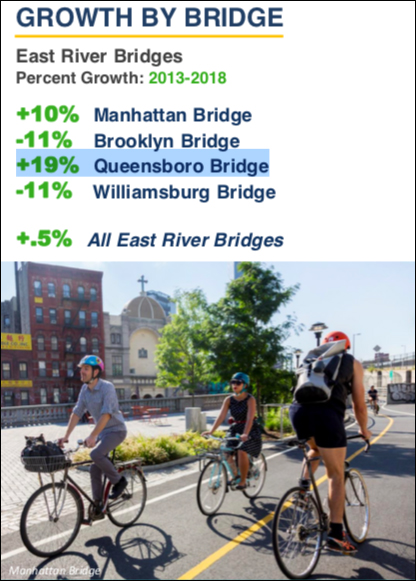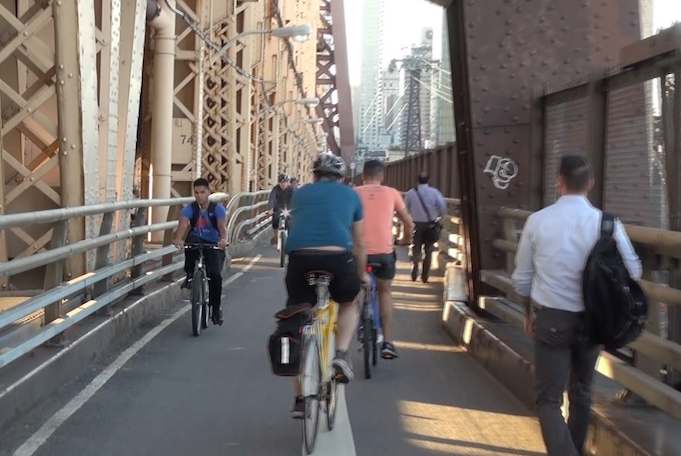The city's failure to give more space to the increasing number of pedestrians and cyclists on the Queensboro Bridge is a betrayal of Vision Zero — and that failure seems based on a fealty to car traffic on a span where bikes and walkers sometimes outnumber drivers.
East Side Council Member Ben Kallos and his Queens counterpart Jimmy Van Bramer blasted Department of Transportation officials for their continued claim that they cannot convert the south side of the bridge's outermost lane, also known as the South Outer Roadway, into a pedestrian path so that walkers do not need to share the bridge's narrow North Outer Roadway with cyclists, who are increasing by double-digit counts.
"Clearly, having pedestrians and cyclists share the North Outer Roadway is creating unnecessary conflicts," Kallos told Streetsblog, which has reported on the dangers — and on how cyclists and pedestrians sometimes outnumber drivers on the bridge. "They should open the South Outer Roadway to pedestrians now. There is no reason to wait. Vision Zero dictates that we're supposed to be making more space for pedestrians and cyclists at the expense of public space for cars."

On Friday, Kallos and Van Bramer will rally with activists and commuters at the Manhattan entrance to the South Outer Roadway (across the street from 334 E. 59th Street) to demand an end to the charade of car hegemony over vital public space — especially at a time when bike commuting over the bridge is up 19 percent since 2013, the city says.
The Department of Transportation says it is studying the idea, but claims that it can’t change anything until 2022, when it will complete its reconstruction of the bridge’s upper roadway. Until then, it says, the South Outer Roadway must compensate for lost vehicular capacity on the span, which currently has five outbound lanes all day.
Kallos isn't buying what the DOT is selling.
"We'd like to see some proof," he said. "This is an outgoing lane only, so during the morning rush hour, a pedestrian path would have no impact. And congestion pricing will add a toll to the 59th Street Bridge [starting in January, 2021], so they need to show data why one outbound lane would have such drastic implications that they can't just do this now."
Van Bramer also doesn't believe the DOT explanation — but went further to say that he no longer believes the mayor cares about his own Vision Zero initiative.
"There is no question in my mind that if there was a will to get it done, it would be done," he said. "It’s a stall tactic. It’s nonsense. It’s a smokescreen."
Van Bramer recounted a recent bike ride along the length of Queens Boulevard, which has a protected bike lane for about three-quarters of the stretch — a bike lane that disappears because the mayor has not committed to finishing his own project.
"Once we passed Yellowstone [Boulevard], where the protected bike lane ends, one of the people on the ride with me says, 'Why do you think this isn’t done yet? Isn't Vision Zero the mayor's thing?' And I just said, 'No, I don’t think this is his thing.' He doesn't come at it from the same place as we do. Things get stalled or politics gets in the way of giving space and safety to cyclists and pedestrians."
Kallos and Van Bramer are the latest to call for more pedestrian space on the Queensboro Bridge. Transportation Alternatives has been petitioning on the issue for more than a year, and Bike NY is also agitating.
"The shared path on the north side is insufficient for the growing numbers of pedestrians and cyclists," those groups said a statement. "Transitioning away from cars requires more space for sustainable transportation."
After initial publication of this story Department of Transportation spokesman Brian Zumhagen sent over the following statement, which only confirmed the agency's 2022 timeline:
We still consider the South Outer Roadway as essential during the reconstruction. However, as we have said in the past, we are evaluating different lane scenarios to understand the impacts and modifications that would be required to convert the SOR to a pedestrian path and use the North Outer Roadway as an exclusive bicycle facility. If found to be feasible, this conversion could be timed to coincide with the completion of the construction work.






